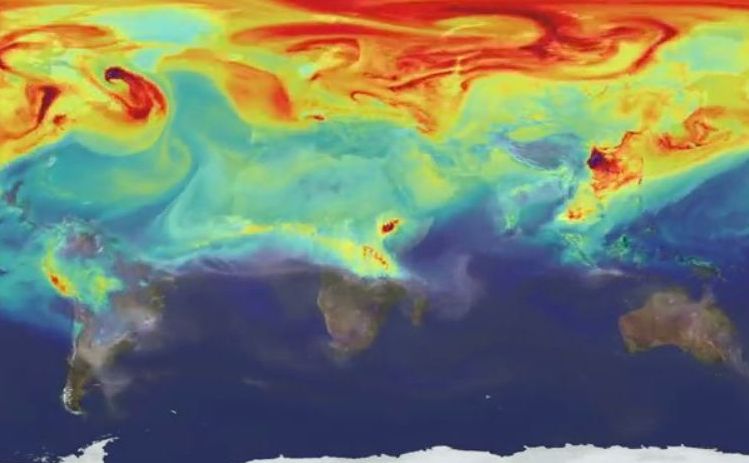Turning the Climate Tide by 2020

Screenshot of visualization "A Year in the life of Earth's CO2", by NASA Goddard (see below for more info)
This call for strong short-term measures complements the longer-term 'carbon law' approach introduced earlier this year by some of the current co-authors, including the Potsdam Institute’s Director Hans Joachim Schellnhuber, in the equally eminent journal Science. Thus a full narrative of deep decarbonization emerges.
“We stand at the doorway of being able to bend the GHG emissions curve downwards by 2020, as science demands, in protection of the UN Sustainable Development Goals, and in particular the eradication of extreme poverty,” Christiana Figueres says, lead-author of the Nature comment and former head of the United Nations Framework Convention on Climate Change (UNFCCC).
“This monumental challenge coincides with an unprecedented openness to self-challenge on the part of sub-national governments inside the US, governments at all levels outside the US, and of the private sector in general. The opportunity given to us over the next three years is unique in history.” Figueres is the convener of Mission 2020, a broad-based campaign calling for urgent action now to make sure that carbon emissions begin an inexorable fall by 2020.
The authors and co-signatories to the Nature article comprise over 60 scientists, business and policy leaders, economists, analysts and influencers, including Gail Whiteman from Lancaster University; Sharan Burrow, General Secretary of the International Trade Union Confederation; Paul Polman, Chief Executive Officer of Unilever plc; Anthony Hobley, Chief Executive of Carbon Tracker; Christian Rynning-Tønnesen, CEO of Statkraft; and Jonathan Bamber, President of the European Geosciences Union.
The great sustainability transformation
The authors are confident that both technological progress and political momentum have reached a point now that allows to kick-start the 'great sustainability transformation'. 2020 is crucial, because in that year the US will be legally able to withdraw from the Paris Agreement. Even more compelling are the physics-based considerations, however: Recent research has demonstrated that keeping global warming below 2 degrees Celsius becomes almost infeasible if we delay climate action beyond 2020. And breaching the 2°C-line would be dangerous, since a number of Earth system tipping elements, such as the great ice sheets, may get destabilized in that hot-house.
“We have been blessed by a remarkably resilient planet over the past 100 years, able to absorb most of our climate abuse,” says Johan Rockström from the Stockholm Resilience Centre, co-author of the Nature comment and lead-author of the Science article. “Now we have reached the end of this era, and need to bend the global curve of emissions immediately, to avoid unmanageable outcomes for our modern world.”
Six milestones for 2020
Indeed, a social tipping point for the better is in sight, the experts show. Power generation from wind and solar is booming already. In Europe, for instance, more than three quarters of new energy capacities installed rely on those renewable sources. China is quickly establishing a national emissions trading scheme. Financial investors such as BlackRock in the US are growing wary of carbon risks.
The six milestones for 2020 as defined in the article reach from energy (pushing renewables to 30% of total energy supply and retiring all coal-fired power plants) to transport (electric vehicles making up 15% of new car sales globally, up from roughly 1% today) and finance (mobilize 1 trillion US dollars a year for climate action).
“The climate math is brutally clear: While the world can't be healed within the next few years, it may be fatally wounded by negligence until 2020,” concludes Hans Joachim Schellnhuber from the Potsdam Institute for Climate Impact Research, co-author of both the Nature comment and the Science article. Action by 2020 is necessary, but clearly not sufficient – it needs to set the course for halving CO2 emissions every other decade. In analogy to the legendary Moore’s Law, which states that computer processors double in power about every two years, the 'carbon law' can become a self-fulfilling prophecy mobilizing innovations and market forces, says Schellnhuber. “This will be unstoppable – yet only if we propel the world into action now.”
Article: Christiana Figueres, Hans Joachim Schellnhuber, Gail Whiteman, Johan Rockström, Anthony Hobley, Stefan Rahmstorf (2017): Three years to safeguard our climate. Nature [DOI: 10.1038/546593a]
Weblink to the article: https://www.nature.com/news/three-years-to-safeguard-our-climate-1.22201
Weblink to information about the recently published Science article: https://www.pik-potsdam.de/news/press-releases/use-a-201ccarbon-law201d-to-achie…
For further information please contact:
PIK press office
Phone: +49 331 288 25 07
E-Mail: press@pik-potsdam.de
Twitter: @PIK_Climate
https://www.nature.com/news/three-years-to-safeguard-our-climate-1.22201 – Weblink to the article
Media Contact
More Information:
http://www.pik-potsdam.deAll latest news from the category: Earth Sciences
Earth Sciences (also referred to as Geosciences), which deals with basic issues surrounding our planet, plays a vital role in the area of energy and raw materials supply.
Earth Sciences comprises subjects such as geology, geography, geological informatics, paleontology, mineralogy, petrography, crystallography, geophysics, geodesy, glaciology, cartography, photogrammetry, meteorology and seismology, early-warning systems, earthquake research and polar research.
Newest articles

NASA: Mystery of life’s handedness deepens
The mystery of why life uses molecules with specific orientations has deepened with a NASA-funded discovery that RNA — a key molecule thought to have potentially held the instructions for…

What are the effects of historic lithium mining on water quality?
Study reveals low levels of common contaminants but high levels of other elements in waters associated with an abandoned lithium mine. Lithium ore and mining waste from a historic lithium…

Quantum-inspired design boosts efficiency of heat-to-electricity conversion
Rice engineers take unconventional route to improving thermophotovoltaic systems. Researchers at Rice University have found a new way to improve a key element of thermophotovoltaic (TPV) systems, which convert heat…



